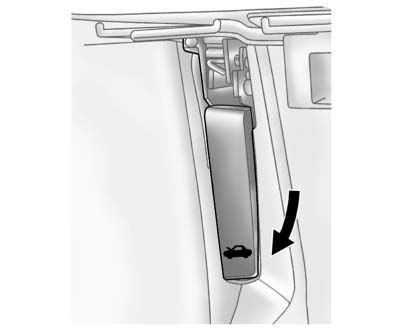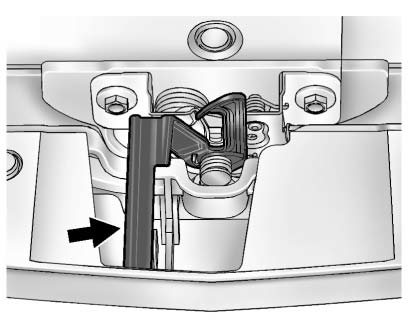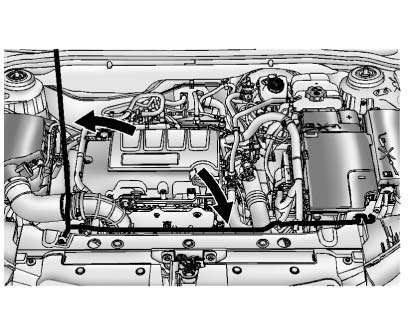Chevrolet Cruze Owners Manual: Hood
To open the hood:

1. Pull up on the hood release handle. It is located inside the vehicle to the left of the steering column.

2. Go to the front of the vehicle and push the secondary hood release handle toward the driver side of the vehicle.

3. Lift the hood and release the hood prop from its retainer, located above the radiator.
Securely place the hood prop into the slot on the underside of the hood.
To close the hood:
1. Before closing the hood, be sure all the filler caps are on properly.
Then, lift the hood to relieve pressure on the hood prop.
Remove the hood prop from the slot on the underside of the hood and return the prop to its retainer. The prop rod must click into place when returning it to the retainer to prevent hood damage.
2. Lower the hood 30 cm (12 in) above the vehicle and release it so it fully latches. Check to make sure the hood is closed and repeat the process if necessary.
 Doing Your Own Service Work
Doing Your Own Service Work
WARNING
It can be dangerous to work on your vehicle if you do not have the proper
knowledge, service manual, tools, or parts. Always follow owner manual procedures
and consult the service manual ...
 Engine Compartment Overview
Engine Compartment Overview
1.4L L4 Engine
1. Engine Air Cleaner/Filter
2. Engine Oil Dipstick.
3. Engine Cooling Fan (Out of View).
4. Engine Oil Fill Cap.
5. Remote Negative (-) Grounding Point.
6. Brake/Clutch ...
Other materials:
Installation Procedure
Align the rear compartment floor panel.
Drill 4 mm (3/16 in) for rivets along the edges of the rear compartment
floor were you cant apply a resistance spot welder.
Clean and prepare the attaching surfaces for
spot welding and riveting.
Apply structural adhesive to all a ...
Rear Suspension
Specifications
Rear Suspension Components
Rear Shock Absorber Upper Mount
Rear Shock Absorber Upper Mount
Rear Shock Absorber Upper Mount
Rear Shock Absorber Upper Mount
Shock Absorber Assembly
Upper Dumping Ring
Rear Spring
Lower Dumping Ring
Rear Axle Bushing
Rear Ax ...
Head Restraints
The vehicle's front and rear seats have adjustable head restraints in the outboard
seating positions.
WARNING
With head restraints that are not installed and adjusted properly, there is
a greater chance that occupants will suffer a neck/ spinal injury in a crash. Do
not drive until the h ...
